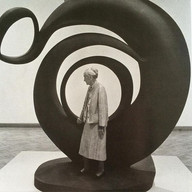Georgia Totto O'Keeffe
Updated: Aug 7, 2022
1887 – 1986

Georgia O'Keeffe was an American artist, best known for her paintings of enlarged flowers, and New Mexico landscapes. She has been recognized as the "Mother of American Modernism". She was born in 1887, in a farmhouse in Sun Prairie, Wisconsin. Her parents, Francis O'Keeffe and Ida (Totto) O'Keeffe were dairy farmers of Irish descent and her maternal grandfather, George Victor Totto, for whom O'Keeffe was named, was a Hungarian count who came to the United States in 1848. In 1905, O'Keeffe began her serious formal art training at the School of the Art Institute of Chicago and then the Art Students League of New York, but she felt constrained by her lessons that focused on recreating nature. After several years of teaching and working as an illustrator, in 1914 O'Keeffe began creating simplified images of natural things, such as leaves, flowers, and rocks which depicted her notion of a simple, meaningful life.
When the famous photographer and gallerist, Alfred Stieglitz first saw O'Keeffe's abstract charcoal drawings, he immediately exhibited her work. Searching for what he called “the Great American Thing,” O'Keeffe was part of the Stieglitz Circle of contemporary New York artists, and by the mid-1920s, she had become the first female painter to gain acclaim alongside her male contemporaries in New York's competitive art world, with her distinctive way of rendering nature in shapes and forms.
In the summer of 1929, O'Keeffe found a new direction for her art when she made her first visit to northern New Mexico. The landscape, architecture and local Navajo culture which would inspire her for the rest of her life.
While in New Mexico, O’Keeffe spent summers and falls at her Ghost Ranch, putting up with the region's hottest days in order to capture its most vivid colors. She often camped out in the harsh surrounding terrain, to keep close to the landscapes that inspired her. Even inclement weather she would set up camp with tents from tarps, and paint with gloves well into her 70s. She took many treks into the desert to paint, and her studio was the backseat of a Model A Ford. She removed much of the interior and would unbolt and reverse the passenger seat and lay the canvas on the backseat to paint out of the hot sun. When she was in her nineties and losing her eyesight, she concentrated on working in clay and sculptures, with the assistant and longtime collaborator, Juan Hamilton.
Georgia O'Keeffe was the first woman artist to have a retrospective at the Museum of Modern Art in Manhattan. O'Keeffe was elected to the American Academy of Arts and Letters and in 1966 was elected a Fellow of the American Academy of Arts and Sciences. Among her awards and honors, she received an honorary degree from Harvard University, and the Presidential Medal of Freedom, the highest honor awarded to American civilians. In 1985 she was awarded the National Medal of Arts.
"I've been absolutely terrified every moment of my life and
I've never let it keep me from doing a single thing I wanted to do."
Georgia O’Keeffe
THURSDAY CLASS
This week we concentrated on Georgia O'Keeffe's sculptures and landscapes.
Thursday's class did oil pastel studies of the desert and a shell to recreate
near abstract and atmospheric pieces. They also had time
to work with clay.
SATURDAY CLASS
On Saturday, the class worked with colored chalk to try to achieve some of the
soft desert hues that are in her landscapes with very interesting results. O'Keeffe
is an artist that warrants a lot more time.









































Comments